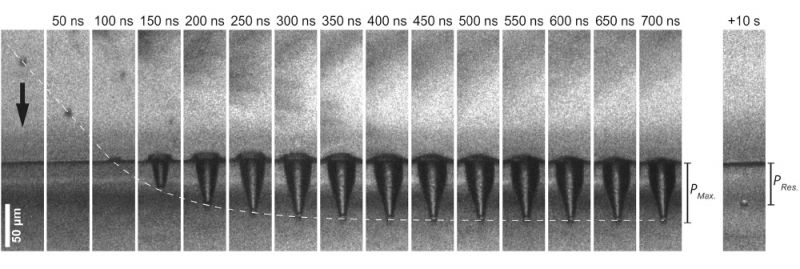Ultra high-speed photography has been used by scientists at the Massachusetts Institute of Technology to study high-velocity micro-particle impact on gelatine and synthetic hydrogel. Potential advancements are, guiding the design of drug delivery methods using accelerated microparticles and the assessment of explosive–related injuries for better forensic interpretation in cases where fragments originating from explosions can cause severe tissue damage injuries. Micro debris, which typically travels at supersonic velocities, can cause serious injury by penetrating deep into tissue where it is hard to detect using standard medical imaging methods.
Multi–frame sequence showing a high-velocity impact on 10 wt% gelatine at 1290 m/s.
The research investigates the high-velocity impact response of gelatine and synthetic hydrogel samples using a laser-induced microparticle impact test platform for launching and imaging supersonic micro-particles travelling up to 1,500m/s. The micro-particles, typically less than 10um in diameter are captured prior and during impact penetration into translucent gels using a Specialised Imaging SIMX16 ultra high-speed multi-frame camera, capable of recording up to 16 images with nanosecond interframe time and short exposure times (down to 3ns) to stop motion blur. Illumination was provided by the Cavilux 640nm wavelength laser.
The impact response was quantified using the images by measuring pre-impact velocity, particle penetration depth and charted against time. These results were compared against a Poncelet predictive model for different gelatine samples. Further tests and measurements were conducted using an engineered protein hydrogel to investigate whether the Poncelet model could be applied to other soft materials which might be expensive to manufacture or otherwise in short supply.
The results indicate the Poncelet model provided a reasonable prediction of micro particle penetration and could offer an initial estimation of deformation of soft materials at high strain rates in more complex models.
See the Research Article here >> https://www.specialised-imaging.com/application/fi...




























